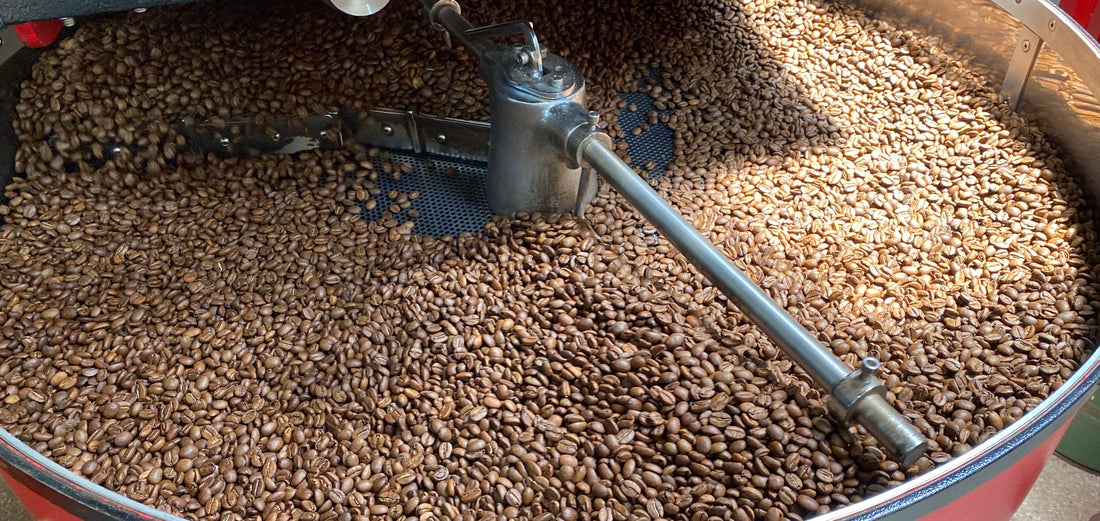Planting

A coffee bean is essentially a seed that can be dried, roasted, and ground to make coffee. However, if the seed is left untreated, it has the potential to sprout and grow into a coffee tree.
To cultivate coffee trees, the seeds are usually planted in shaded nurseries in large beds. The young plants require frequent watering and protection from direct sunlight until they are strong enough to be transplanted permanently. This is typically done during the rainy season, as the soil moisture helps the roots to establish firmly.
Harvesting the Cherries

Coffee trees usually take about 3-4 years to produce fruit, known as the coffee cherry. Once the cherry turns bright red, it is ready for harvesting, which usually happens once a year in most countries. However, in some countries like Colombia, there may be a main and secondary crop due to two annual flowerings.
Coffee harvesting can be done by hand or by machine. With strip picking, all cherries are stripped off the branch at once, while selectively picking involves handpicking only the ripe cherries every 8-10 days. This method is mainly used for higher quality Arabica beans due to its higher cost and labor intensity.
A skilled picker can collect 100-200 pounds of cherries per day, yielding 20-40 pounds of beans. The day's harvest is weighed and transported to the processing plant, where it will be further prepared.
Processing the Cherries

After coffee cherries are picked, they need to be processed quickly to prevent spoilage. This is done using one of two methods depending on location and resources.
The Dry Method involves spreading freshly picked cherries out on large surfaces to dry in the sun. They are raked and turned throughout the day and covered at night to prevent them from getting wet. This process could take several weeks for each batch of coffee depending on the weather until the cherries' moisture content drops to 11%.
The Wet Method removes the skin and pulp from the bean after passing through a pulping machine. The beans are separated by weight, then placed in water-filled fermentation tanks to remove the slick layer of mucilage still attached to the parchment. Enzymes naturally dissolve this layer, and the beans are rinsed and dried after fermentation is complete.
Both methods result in rough-textured beans that are ready for further processing.
Drying the Beans

If the beans have been processed by the wet method, the pulped and fermented beans must now be dried to approximately 11% moisture to properly prepare them for storage.
These beans, still inside the parchment envelope (the endocarp), can be sun-dried by spreading them on drying tables or floors, where they are turned regularly, or they can be machine-dried in large tumblers. The dried beans are known as parchment coffee, and are warehoused in jute or sisal bags until they are readied for export.
Milling the Beans

The parchment coffee is hulled to remove the endocarp, and the dry process removes the entire husk. Polishing is optional and removes the silver skin left after hulling. Grading and sorting is done by size, weight, and color flaws. Beans are separated by air jet and sized based on a scale of 10 to 20. Defective beans are removed by hand or machine to ensure only high-quality coffee is exported.
Roasting the Beans

Roasting transforms green coffee into the aromatic brown beans that we purchase in our favorite stores or cafés. Most roasting machines maintain a temperature of about 550 degrees Fahrenheit. The beans are kept moving throughout the entire process to keep them from burning.
When they reach an internal temperature of about 400 degrees Fahrenheit, they begin to turn brown and the caffeol, a fragrant oil locked inside the beans, begins to emerge. This process called pyrolysis is at the heart of roasting — it produces the flavor and aroma of the coffee we drink.
After roasting, the beans are immediately cooled either by air or water. Roasting is generally performed in the importing countries because freshly roasted beans must reach the consumer as quickly as possible.
Tasting the Coffee

Coffee undergoes a quality and taste assessment process called cupping, which occurs in a specialized room. First, the cupper inspects the visual quality of the beans before roasting, grinding, and infusing them in boiling water. The cupper smells the coffee to evaluate its aroma and breaks the crust before tasting by slurping a spoonful, spraying it evenly over their taste buds, and weighing it on their tongue before spitting it out. Samples from various batches and beans are tasted daily to analyze their characteristics and flaws and to create the proper roast or blend. A seasoned cupper can taste subtle differences between hundreds of coffee samples each day.
Grinding Coffee

The objective of a proper grind is to get the most flavor in a cup of coffee. How coarse or fine the coffee is ground depends on the brewing method.
The length of time the grounds will be in contact with water determines the ideal grade of grind Generally, the finer the grind, the more quickly the coffee should be prepared. That’s why coffee ground for an espresso machine is much finer than coffee brewed in a drip system.
Brewing Coffee

Reference Document 10 Steps from Seed to Cup (ncausa.org)

